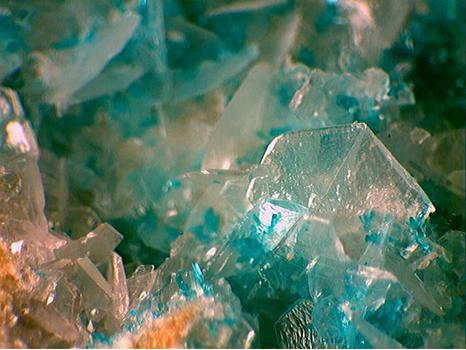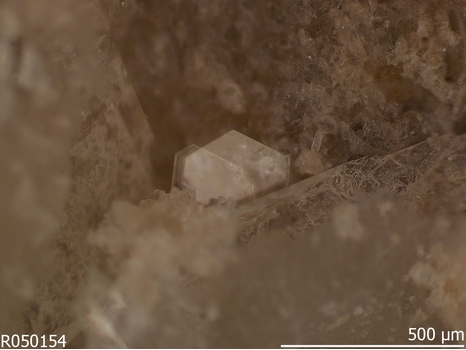Junitoite
A valid IMA mineral species
This page is currently not sponsored. Click here to sponsor this page.
About Junitoite
Formula:
CaZn2Si2O7 · H2O
Colour:
Colorless
Lustre:
Adamantine, Vitreous, Sub-Vitreous
Hardness:
4½
Specific Gravity:
3.5
Crystal System:
Orthorhombic
Name:
Named by Sidney Arthur Williams in 1976 in honor of Jun Ito (25 September 1926, Japan - 6 June 1978, Chicago, Illinois, USA), mineralogist and crystallographer, University of Chicago, Chicago, IL, USA. He first noted the compound, in 1968, in a series of experiments of synthesis of Pb-Ca-Zn silicates.
This page provides mineralogical data about Junitoite.
Unique Identifiers
Mindat ID:
2123
Long-form identifier:
mindat:1:1:2123:0
GUID
(UUID V4):
(UUID V4):
cb37ada6-a7ff-4154-9615-a83ac9fd21aa
IMA Classification of Junitoite
Approved
First published:
1976
Classification of Junitoite
9.BD.15
9 : SILICATES (Germanates)
B : Sorosilicates
D : Si2O7 groups, with additional anions; cations in tetrahedral [4] and greater coordination
9 : SILICATES (Germanates)
B : Sorosilicates
D : Si2O7 groups, with additional anions; cations in tetrahedral [4] and greater coordination
56.2.1.1
56 : SOROSILICATES Si2O7 Groups, With Additional O, OH, F and H2O
2 : Si2O7 Groups and O, OH, F, and H2O with cations in [4] and/or >[4] coordination
56 : SOROSILICATES Si2O7 Groups, With Additional O, OH, F and H2O
2 : Si2O7 Groups and O, OH, F, and H2O with cations in [4] and/or >[4] coordination
14.7.17
14 : Silicates not Containing Aluminum
7 : Silicates of Ba, Sr and Zn
14 : Silicates not Containing Aluminum
7 : Silicates of Ba, Sr and Zn
Mineral Symbols
As of 2021 there are now IMA–CNMNC approved mineral symbols (abbreviations) for each mineral species, useful for tables and diagrams.
| Symbol | Source | Reference |
|---|---|---|
| Jit | IMA–CNMNC | Warr, L.N. (2021). IMA–CNMNC approved mineral symbols. Mineralogical Magazine, 85(3), 291-320. doi:10.1180/mgm.2021.43 |
Physical Properties of Junitoite
Adamantine, Vitreous, Sub-Vitreous
Transparency:
Transparent
Colour:
Colorless
Comment:
Sometimes milky white to pale lavender due to alteration.
Streak:
White
Hardness:
4½ on Mohs scale
Tenacity:
Very brittle
Cleavage:
Very Good
{010} very good,{100} and {101} are poor.
{010} very good,{100} and {101} are poor.
Fracture:
Micaceous
Comment:
Breaks somewhat like mica in that the plates separate easily by breaking using a sharp point.
Density:
3.5 g/cm3 (Measured) 3.506 g/cm3 (Calculated)
Comment:
Dcalc from Yang et al. (2012)
Optical Data of Junitoite
Type:
Biaxial (+)
RI values:
nα = 1.656 nβ = 1.664 nγ = 1.672
2V:
Measured: 86° , Calculated: 88°
Birefringence:
0.016
Max Birefringence:
δ = 0.016

Image shows birefringence interference colour range (at 30µm thickness)
and does not take into account mineral colouration.
and does not take into account mineral colouration.
Surface Relief:
Moderate
Dispersion:
r < v, very weak
Optical Extinction:
X = b; Y = a; Z = c.
Pleochroism:
Non-pleochroic
Chemistry of Junitoite
Mindat Formula:
CaZn2Si2O7 · H2O
Crystallography of Junitoite
Crystal System:
Orthorhombic
Class (H-M):
mm2 - Pyramidal
Space Group:
Aba2
Cell Parameters:
a = 12.51 Å, b = 6.31 Å, c = 8.56 Å
Ratio:
a:b:c = 1.983 : 1 : 1.357
Unit Cell V:
675.71 ų (Calculated from Unit Cell)
Z:
4
Morphology:
Crystals to 5mm with hemimorphic development. c {001}, b {010}, k {101}, p {111}, r {131}, -r {131}, -g {191}. (Viscinal forms may show herringbone pattern ["whishbone"]).
Comment:
Cell re-set from original
Crystal Structure
Load
Unit Cell | Unit Cell Packed
2x2x2 | 3x3x3 | 4x4x4
Unit Cell | Unit Cell Packed
2x2x2 | 3x3x3 | 4x4x4
Show
Big Balls | Small Balls | Just Balls | Spacefill
Polyhedra Off | Si Polyhedra | All Polyhedra
Remove metal-metal sticks
Big Balls | Small Balls | Just Balls | Spacefill
Polyhedra Off | Si Polyhedra | All Polyhedra
Remove metal-metal sticks
Display Options
Black Background | White Background
Perspective On | Perspective Off
2D | Stereo | Red-Blue | Red-Cyan
Black Background | White Background
Perspective On | Perspective Off
2D | Stereo | Red-Blue | Red-Cyan
View
CIF File Best | x | y | z | a | b | c
CIF File Best | x | y | z | a | b | c
Rotation
Stop | Start
Stop | Start
Labels
Console Off | On | Grey | Yellow
Console Off | On | Grey | Yellow
Data courtesy of the American Mineralogist Crystal Structure Database. Click on an AMCSD ID to view structure
| ID | Species | Reference | Link | Year | Locality | Pressure (GPa) | Temp (K) |
|---|---|---|---|---|---|---|---|
| 0019356 | Junitoite | Yang H, Jenkins N G, Downs R T (2012) Redetermination of junitoite, CaZn2Si2O7*H2O Acta Crystallographica E68 i73-i73 |  | 2012 | Christmas Mine, Gila County, Arizona, USA | 0 | 293 |
| 0014480 | Junitoite | Hamilton R D, Finney J J (1985) The structure of junitoite, CaZn2Si2O7*H2O Mineralogical Magazine 49 91-95 |  | 1985 | Christmas mine, Gile County, Arizona, USA | 0 | 293 |
CIF Raw Data - click here to close
X-Ray Powder Diffraction
Powder Diffraction Data:
| d-spacing | Intensity |
|---|---|
| 6.25 Å | (40) |
| 4.70 Å | (50) |
| 3.53 Å | (100) |
| 2.82 Å | (100) |
| 2.54 Å | (100) |
| 2.52 Å | (50) |
| 2.35 Å | (70) |
| 1.540 Å | (60) |
Comments:
ICDD 29-394
Geological Environment
Paragenetic Mode(s):
| Paragenetic Mode | Earliest Age (Ga) |
|---|---|
| High-𝑇 alteration and/or metamorphism | |
| 32 : Ba/Mn/Pb/Zn deposits, including metamorphic deposits | |
| Stage 7: Great Oxidation Event | <2.4 |
| 47a : [Near-surface hydration of prior minerals] |
Type Occurrence of Junitoite
General Appearance of Type Material:
Randomly oriented colorless to lavender platy crystals up to 5 x 0.5 mm.
Place of Conservation of Type Material:
University of Arizona, Tucson, Arizona, USA.
Harvard University, Cambridge, Massachusetts, USA, 119097.
National Museum of Natural History, Washington, D.C., USA, 136688.
University of Paris, Paris, France.
National School of Mines, Paris, France.
The Natural History Museum, London, England, 1980,535.
Harvard University, Cambridge, Massachusetts, USA, 119097.
National Museum of Natural History, Washington, D.C., USA, 136688.
University of Paris, Paris, France.
National School of Mines, Paris, France.
The Natural History Museum, London, England, 1980,535.
Geological Setting of Type Material:
Contact metamorphosed zinc orebody.
Associated Minerals at Type Locality:
Reference:
Williams, S.A. (1976) Junitoite, a new hydrated calcium zinc silicate from Christmas, Arizona. American Mineralogist, 61, 1255-1258.
Synonyms of Junitoite
Other Language Names for Junitoite
Common Associates
Associated Minerals Based on Photo Data:
| 7 photos of Junitoite associated with Kinoite | Ca2Cu2(H2O)2[Si3O10] |
| 4 photos of Junitoite associated with Dioptase | CuSiO3 · H2O |
| 3 photos of Junitoite associated with Smectite Group | A0.3D2-3[T4O10]Z2 · nH2O |
| 2 photos of Junitoite associated with Chalcanthite | CuSO4 · 5H2O |
| 2 photos of Junitoite associated with Gilalite | Cu5Si6O17 · 7H2O |
| 1 photo of Junitoite associated with Sauconite | Na0.3Zn3((Si,Al)4O10)(OH)2 · 4H2O |
| 1 photo of Junitoite associated with Ruizite | Ca2Mn3+2[Si4O11(OH)2](OH)2 · 2H2O |
| 1 photo of Junitoite associated with Hydroxyapophyllite-(K) | KCa4(Si8O20)(OH,F) · 8H2O |
Related Minerals - Strunz-mindat Grouping
| 9.BD.05 | Bertrandite | Be4(Si2O7)(OH)2 |
| 9.BD.10 | Hemimorphite | Zn4Si2O7(OH)2 · H2O |
| 9.BD.20 | Axinite-(Fe) | Ca2Fe2+Al2BSi4O15OH |
| 9.BD.20 | Axinite-(Mg) | Ca2MgAl2BSi4O15OH |
| 9.BD.20 | Axinite-(Mn) | Ca2Mn2+Al2BSi4O15(OH) |
| 9.BD.20 | Tinzenite | Ca2Mn2+4Al4[B2Si8O30](OH)2 |
| 9.BD.25 | Vistepite | SnMn4B2Si4O16(OH)2 |
| 9.BD.30 | Boralsilite | Al16B6O30(Si2O7) |
| 9.BD.35 | Werdingite | (Mg,Fe)2Al14Si4B4O37 |
| 9.BD.40 | Vránaite | Al16B4Si4O38 |
Fluorescence of Junitoite
Not fluorescent.
Other Information
Thermal Behaviour:
Strongly pyroelectric.
Notes:
Easily soluble in cold 10% HCl or 1:7 HNO3, but is insoluble in water. Slowly decomposed by hot 40% KOH.
Heated in a closed tube, it quickly turns milky-white, spalling into flakes that separate on {010}. Water is lost during the process, and it fuses to a clear glassy bead.
Heated in a closed tube, it quickly turns milky-white, spalling into flakes that separate on {010}. Water is lost during the process, and it fuses to a clear glassy bead.
Health Risks:
No information on health risks for this material has been entered into the database. You should always treat mineral specimens with care.
Internet Links for Junitoite
mindat.org URL:
https://www.mindat.org/min-2123.html
Please feel free to link to this page.
Please feel free to link to this page.
Search Engines:
External Links:
Mineral Dealers:
References for Junitoite
Reference List:
Ito, Jun (1968) Synthesis of some lead calcium zinc silicates. American Mineralogist, 53 (1-2) 231-240 (synthetic)
Williams, Sidney A. (1976) Junitoite, a new hydrated calcium zinc silicate from Christmas, Arizona. American Mineralogist, 61 (11-12) 1255-1258
Hamilton, R. D., Finney, J. J. (1985) The structure of junitoite, CaZn2Si2O2 · H2O. Mineralogical Magazine, 49 (350) 91-95 doi:10.1180/minmag.1985.049.350.13
Localities for Junitoite
Locality List
 - This locality has map coordinates listed.
- This locality has map coordinates listed.
 - This locality has estimated coordinates.
ⓘ - Click for references and further information on this occurrence.
? - Indicates mineral may be doubtful at this locality.
- This locality has estimated coordinates.
ⓘ - Click for references and further information on this occurrence.
? - Indicates mineral may be doubtful at this locality.
 - Good crystals or important locality for species.
- Good crystals or important locality for species.
 - World class for species or very significant.
(TL) - Type Locality for a valid mineral species.
(FRL) - First Recorded Locality for everything else (eg varieties).
- World class for species or very significant.
(TL) - Type Locality for a valid mineral species.
(FRL) - First Recorded Locality for everything else (eg varieties).
All localities listed without proper references should be considered as questionable.
USA (TL) | |
| Williams (1976) +1 other reference |
| Williams (1976) +1 other reference | |
| Dunn (1995) |
Quick NavTopAbout JunitoiteUnique IdentifiersIMA Classification Classification Mineral SymbolsPhysical Properties Optical Data Chemistry Crystallography Crystal StructureX-Ray Powder DiffractionGeological EnvironmentType Occurrence SynonymsOther LanguagesCommon AssociatesStrunz-MindatFluorescence Other InformationInternet Links References Localities Locality List






 symbol to view information about a locality.
The
symbol to view information about a locality.
The 




Christmas Mine, Christmas, Banner Mining District, Gila County, Arizona, USA